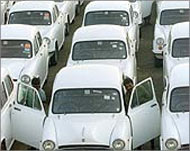India car industry changes gear
The sale of passenger cars in India has nearly doubled in the last five years, and although traffic congestion has offset the advantages of using private vehicles, people are still queuing up to buy them.

The seventh bi-annual auto show in Delhi, where 960 domestic and foreign manufacturers recently displayed their latest models, had ten times more general visitors than the 150,000 business visitors.
The Indian automobile industry’s metamorphosis is best seen on the roads of the nation’s capital. The four million vehicles on its roads has changed the face of Delhi.
“This is not the Delhi I made home two decades ago. In our colony, just a couple of us had cars with lovely trees as sheds. Today, you have two cars per family and hardly any space to park, which even leads to frequent quarrels between neighbours,” said K Choudhary, a guesthouse owner in a posh south Delhi colony.
Delhi and its surrounding towns, comprising the National Capital Region, represent around 16% of India’s car market and, sometimes the city’s 14 million people appear to be doing little else than driving.
“The existing road network is not adequate and overloading of roads is a matter of deep concern,” said Qatar Ahmad, Delhi’s Traffic Police Commissioner.
“Apart from the fact that the number of vehicles has more than doubled in the last 10 years, the same road space is being used by motorised and non-motorised vehicles like bicycles and cycle rickshaws, putting them all at serious risk.”
Burgeoning vehicular traffic has also driven the government to expand road networks within the same space.
“Today there are 63 flyovers in Delhi which do help relieve congestion but then they create the problem of speeding drivers and relocation of bus stops.”
Poor traffic sense
One “indirect way” to control the growing number of cars in the city, Ahmad believes, is to make it mandatory for car owners to have a garage facility before being allowed to own a car.
“How many of us even think about the parking space before we decide on a car!” Even otherwise, traffic sense in Delhi, he said, is “very poor”.
The boom is here to stay. Tata Motors, an indigenous manufacturer, has promised to produce a $2000 car for the masses. |
A large majority of Delhi’s car-owners, whether in commercial or residential areas, parks their vehicles on the roadside and road accidents take a steady toll of life everyday. Last year alone, 7300 people died and tens of thousands were injured in accidents.
However, the poor traffic sense of the average Delhiite and the multiple problems it generates, including air and noise pollution, do not seem to worry the manufacturers.
“Delhi remains the best bet for any auto manufacturer, domestic or foreign. The average purchasing power here is much higher than in the rest of the country. The absence of a rapid transport system also forces people to go in for private transport, and cars seem the safest mode of transport,” said car industry pundit D Deepangshu.
“The average consumer’s emphasis is on utility rather than on style and status,””according to Deepangshu. This could explain the success of medium-sized cars like Hyundai’s Santro, Tata Motors’ Indica and Maruti-Suzuki’s Zen.
Easier finance
Car finance availability has also made it much easier for people to go in for cars rather than bikes and scooters. More than 85% of the cars sold last year were financed by private, foreign banks.
 |
|
The familiar Ambassadors have |
“Today cars on loans are a trend and even those who can afford it are not paying cash down. Low interest rates and incentives given by the car companies to private banks have contributed greatly to the increased demand for cars,” said, Ashok Rane, a banker.
Rane works with a government bank where housing rather than car loans top the list.
“Our staff does not get any incentives from the car companies for enhancing their business. Besides, the mindset of government banks is need rather than luxury-oriented and car is still a luxury in our country.”
What has made the “luxury” affordable for even modest consumers is the lower interest rate, down to 10% from 19% five years ago. The total auto finance has grown three times from (7000 crore rupees) $120 million four years ago. The average period of car ownership has also come down from 10-12 years to less than five years.
Industry sources said there is a big demand for small cars, for their “manoeuvrability through heavy traffic and affordability” but the fantastic growth in the domestic car market is not the only thing they are pleased about.
Export growth
India’s car exports have also recorded an impressive growth. The export of vehicle components stands at $800 million today.
Ford and Suzuki are already using their Indian operations to produce compact cars for markets in Latin America, Asia and Africa. Tata Motors, India’s third largest passenger car company, has signed a deal with Britain’s MG Rover Group to supply 170,000 compact cars over the next five years.
With its huge pool of skilled workforce of engineers and product designers capable of creating low-cost and high-end products, India is fast emerging as an outsourcing centre for foreign cars.
The boom in the auto industry is apparently here to stay. At the Delhi auto exhibition, Tata Motors, a 100% indigenous manufacturer, promised to produce a $2000 car for the masses.